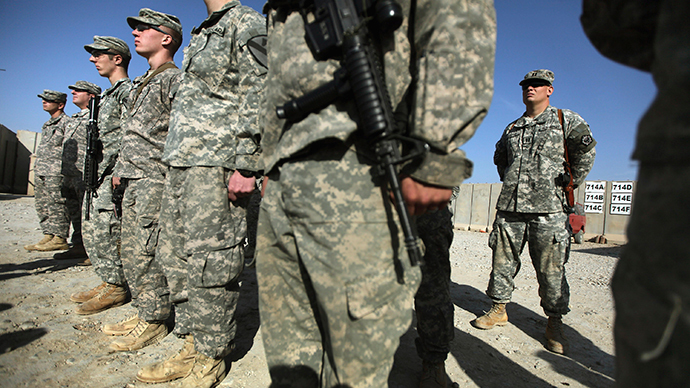CIA bought, destroyed chemical weapons in Iraq following invasion - report

Following the US invasion of Iraq, the CIA worked with US troops in 2005 and 2006 to quietly purchase and recover 1980s-era nerve-agent rockets from a clandestine Iraqi seller during the previously undisclosed Operation Avarice, according to a new report.
Operation Avarice led to the destruction of at least 400 Borak warheads, chemical weapons used by Saddam Hussein’s government that were reportedly manufactured domestically for Iraq’s war against Iran during the 1980s.
Pieces of the leftover cache acquired in 2005 and 2006 by the CIA are believed to have been those not accounted for by the United Nations following the 1991 Persian Gulf war, according to the New York Times.
The program was run out of the CIA’s Baghdad station with the aid of the US Army’s 203rd Military Intelligence Battalion as well as chemical-defense and explosive ordnance disposal troops, according to anonymous US officials that spoke to the Times.
Many of the 40-inch Borak rockets recovered were empty, others in poor shape or contained nonlethal material. Still others were found to have a higher level of sarin than was expected.
The amount of money paid to the secretive Iraqi Borak seller, the only person to offer the chemical munitions to the CIA, is unknown, as are his affiliations.
READ MORE: Washington concealed US troops exposure to chemical weapons in Iraq – intel docs
“Without speaking to any specific programs, it is fair to say that together with our coalition partners in Iraq, the U.S. military worked diligently to find and remove weapons that could be used against our troops and the Iraqi people,” said Pentagon spokesman Rear Adm. John Kirby, the Times reported.
Lauding the program’s success, retired Army Lt. Gen. Richard P. Zahner, the highest-ranking American military intelligence officer in Iraq in 2005 and 2006, said Operation Avarice neutralized what could have become an arsenal used against the US and its allies.
“This was a timely and effective initiative by our national intelligence partners that negated the use of these unique munitions,” he said.
Yet the disclosure of the program again highlighted the US military’s secrecy regarding chemical weapons US troops were or could have been exposed to during the war.
READ MORE: Veterans at risk: 6 key elements of suicide-prevention law
It was revealed in October that American soldiers discovered more than 4,990 mostly degraded chemical munitions in Iraq, yet veterans are now grappling with the effects of chemical exposure that the military did not adequately share with troops or the public.
Veterans have claimed their medical care following this exposure has been substandard, partly because military doctors were unaware of the presence of chemical weapons in Iraq.
“If we were aware of these compounds, and as it became clear over the course of the war that our troops had been exposed to them, why wasn’t more done to protect the guys on the ground?” said Aaron Stein, an associate fellow at the Royal United Services Institute.
“It speaks to the broader failure.”
The US support for Iraq in its war against neighboring Iran is well documented.
"Reagan/Bush administrations permitted—and frequently encouraged—the flow of money, agricultural credits, dual-use technology, chemicals, and weapons to Iraq,” ABC’s Nightline reported in 1992.
In 1994, US Sen. Donald Riegle released a report -- "U.S. Chemical and Biological Warfare-Related Dual Use Exports to Iraq and their Possible Impact on the Health Consequences of the Gulf War" -- that detailed how the US supplied biological research materials to Iraq.
"Records available from the supplier for the period from 1985 until the present show that during this time, pathogenic, toxigenic, and other biological research materials were exported to Iraq pursuant to application and licensing by the U.S. Department of Commerce. Records prior to 1985 were not available, according to the supplier. These exported biological materials were not attenuated or weakened and were capable of reproduction."
READ MORE: 4 in 10 Americans erroneously believe US found active WMDs in Iraq – survey
Operation Avarice began after the US military recovered a small collection of Borak warheads in 2005. The seller would occasionally notify the CIA when he had more for sale, officials said, meeting with American handlers of the program in Iraq’s southeast region to hand off the weapons.
The Boraks were disposed of afterwards, most by detonation, officials said. Some were taken to Camp Slayer, near Baghdad’s airport, for testing.
Sarin analysis of the warheads in 2005 found purity level as high as 13 percent, higher than expected. Borak sarin samples found in 2004 had yielded purity levels no more than 4 percent. One internal record from 2006 referenced “agent purity of up to 25 percent for recovered unitary sarin weapons.”
The relationship between the Borak seller and his American negotiators began to sour, NYT indicated, as the CIA and US troops increasingly pushed for more information on the cache.












